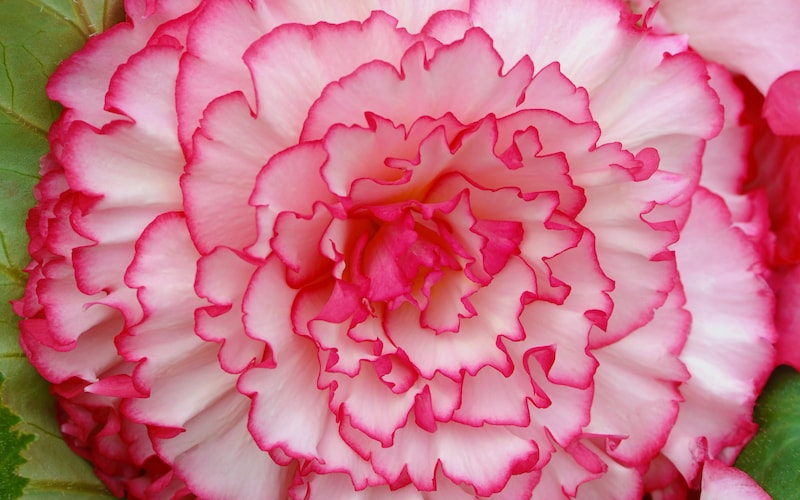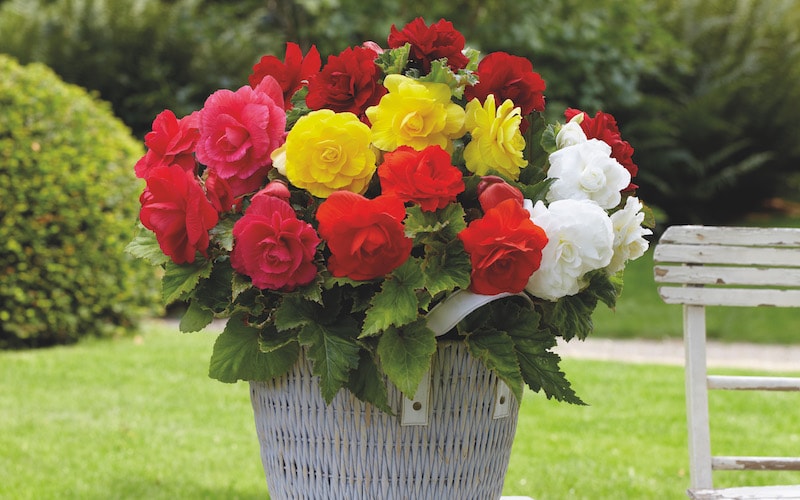The brightly-coloured petals of tuberous begonias are not only beautiful, but edible too. Hugely popular back in the reign of Queen Victoria, the use of edible flowers is once again on the rise. Adding a touch of elegance to any dish, edible petals also lend a subtle and unique flavour to food and drinks. Here’s more information about using begonias in your kitchen, as well as your garden.
Browse our full range of begonia plants for inspiration or pick up begonia tubers for good value colour.
Are all begonias edible?
The flowers of tuberous begonias (Begonia x tuberhybrida) and wax begonias (B. x semperflorens-cultorum) are edible. These pretty petals have a slightly sour citrus flavour and a light, crisp texture. Use the blossoms to brighten up salads and sandwiches or decorate cakes and bakes. Alternatively, use the petals to garnish summer cocktails or freeze into ice cubes for a bright flash of colour in cold drinks.
Tuberous begonias also have edible stems and leaves. The stems can be eaten in the same way as rhubarb, and the snipped leaves lend an interesting twist to salad.
A word of warning. Like many leafy green vegetables, begonia flowers and stems contain the organic compound oxalic acid and are best avoided by sufferers of gout, kidney stones and rheumatism. Anyone who suffers from pollen allergies might also prefer to avoid eating edible flowers altogether.
Not sure if your flower is edible? If in doubt – don’t eat it.
How to harvest and prepare edible flowers

Image: Begonia x tuberhybrida ‘Apricot Shades Improved’ F1 Hybrid from Suttons
- Pick your edible blooms early in the morning when the water content is high
- Give them a shake to dislodge any soil and insects
- Carefully separate and wash the petals in a bowl of water
- Leave them to dry on a clean tea towel
- Edible flowers taste best when picked and eaten on the same day
Tuberous begonias in the garden

Image: Begonia x tuberhybrida ‘Giant Picotee Blush’ from Suttons (©Thompson & Morgan)
Of course, if you don’t fancy munching on begonias you can still enjoy them in your garden. Tuberous begonias are tender perennials, and the mainstay of many summer displays. Available in a wide range of colours, they flower from early summer until the first frosts. Simply choose the form that you prefer – upright, trailing, single-flowered, double-flowered, picotee, frilly-edged, and more.
One of the largest tuberous begonias is ‘Prima Donna‘ with enormous frilled blooms on compact upright stems.
For a cascading variety you won’t go wrong with ‘Apricot Shades’ or Begonia ‘Funky Pink’. And for a striking, ruffled picotee, try ‘Giant Picotee Blush’.
So, whether you plan to eat your begonias or prefer just to feast with your eyes, order your tubers in plenty of time to enjoy a long season of blooms. Looking for growing, overwintering and variety tips? Read our expert advice on how to grow begonias.
Image: Begonia x tuberhybrida ‘Double Flowered Mixed’ from Suttons



Thank you God for the edible flowers of the beautiful Begonias. I can’t get over there beauty, and there taste. This is why I say Thank You God, for them. It just amazes me of his creativity. Beautiful, just Beautiful
Thanks for giving me this information. it is beneficial for me and for more info check this website.